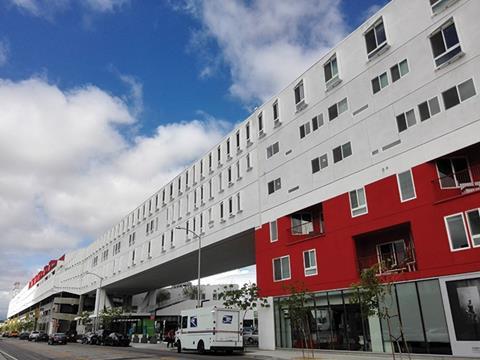The residential population of the City of London has dwindled since the 19th century as it has become a hub of finance. But with the greater city around the Square Mile facing a housing crisis, is it time to reverse that trend?

During the 1851 Great Exhibition, the City of London had a population of just under 130,000, around 6% of London’s residents at the time. Today that figure has plummeted to just over 7,000, approximately 0.08% of London’s current population. The City of London has always been the commercial engine room of the capital and has been home to nationally important financial (and spiritual) institutions for hundreds of years. The difference now is that while the institutions remain, the houses, terraces and flats that once surrounded them have vanished.
The decline began in the mid-19th century when the City embarked on a relentless policy of depopulation. The savage slum clearance gave way to an explosion in construction of palatial Victorian and later Edwardian premises, exclusively for commercial use. Accelerated by world wars and post-war reconstruction and suburbanisation, the population continued to decline rapidly throughout the 20th century, reaching a nadir in the early 1970s. Numbers have risen slightly since then, primarily on the back of the completion of the Barbican in the early 1980s, which marked a strategic post-war attempt to repopulate at least part of the City and which today houses well over half its residents. But the trend is unmistakable: to all intents and purposes the City of London today is open for business, but not for homebuyers.
This status was further enshrined last month when the mayor of London published guidance restricting office-to-residential conversions in the City, as well as much of central London. In 2013 the government relaxed national permitted development rights in an effort to make it easier to convert commercial accommodation to residential, a temporary policy that has recently been made permanent. The intention was to boost the provision of new homes, although the relaxation has been criticised by some for further destabilising an already struggling high street economy, particularly in London where residential property prices have skyrocketed.
The mayor’s new guidance specifically excludes what is dryly referred to as the capital’s “central activities zone” from this national policy. While it acknowledges the existing mixed nature of much of central London to which this zone applies, it specifically identifies the City as an area where residential development is “not appropriate”.
This recent move is in keeping with City planning policy since the war. Peter Rees, the City’s ex-planning chief, was adamant that residential development should be kept out of the City and only gave permission for one residential City tower during his 29-year tenure, which coincidentally he also happens to now live in.
Similarly the City of London Corporation, the City’s ancient municipal authority that also administers land and services throughout Greater London, last year pledged to provide 3,700 new homes in London by 2025. None are earmarked for the City.
This flies in the face of seismic demographic changes in the capital. With London’s population recently surpassing its 1939 peak and predicted by some to reach 13 million by 2050, this will add further pressure to what is already an acute housing shortage. It is widely accepted that London’s 33 boroughs (including the City) need to be building a minimum of 49,000 homes a year for at least the next 10 years to meet the anticipated demand.

While the Greater London Authority (GLA) has identified housing targets for the City over coming decades, they are comparatively insubstantial and by far the lowest in London. Moreover, the Corporation itself justifies its reluctance to build housing by claiming that it “is committed to increasing housing supply in the capital beyond the boundaries of the Square Mile” and that “the economy is best served by supporting the agglomeration of the financial sector, and that the capital’s housing needs will not be met by selective developments in the prime commercial market”.
Is this indeed the case? And if it is, what wider implications does the City’s promotion of its commercial monoculture have on urban design principles that normally suggest cities are most successful when they aspire towards mixed, active communities? Is the City’s approach essential to protect its preeminent commercial status or is it a symptom of a corporatised and regressive social policy that prioritises financial gain over urgent housing need?
Advantages
There are distinct advantages and disadvantages to the City’s approach and each one has wider ramifications for the nature and tenure of urban redevelopment elsewhere. For one thing the City of London is tiny and whatever housing expansion it were to embark on would be unlikely to have a significant impact on London’s housing shortage. While it is slightly bigger than its colloquial “Square Mile” pseudonym might suggest, it is still the smallest “city” in England and the third smallest in the UK.
It is also inarguable that the City remains a global commercial powerhouse, regularly exchanging the title of world’s leading financial centre with New York. While there is no direct evidence to suggest that additional housing might threaten this status, the City’s preeminent position lends credence to its “if it ain’t broke” analysis.
According to professor Tony Travers of the London School of Economics’ London unit, the perceived threat from residential development is a big motivation behind the City’s punitive housing policy. “I think the City believes that having residents in the core of its area would make it harder to develop – both in terms of noisy works but also because residential buildings cannot easily be re-converted to commercial use. The idea of a major concentration of offices and commercial towers also appeals to the City: any loss to residential weakens the ‘agglomeration’ effect and the city sees itself as an agglomeration within a bigger agglomeration.”
This issue of agglomeration is significant. Central London extends over a much larger area than the City and the City’s restrictive housing approach has not prevented the residential population of the remainder of central London rising exponentially in recent decades, as Travers also points out: “The City is only a part of London’s central business district (which is itself growing). Other parts of central London are increasing their population, notably the West End (Westminster and Camden), Docklands, Southwark riverside, north Lambeth, south Hackney and south Islington.” To support this point, Kensington and Chelsea, central London’s most westerly borough, remains the densest borough in the capital and the fourth densest in the UK.

Additionally, while the City’s housing approach may appear politically reactionary against the backdrop of London’s current housing shor
















